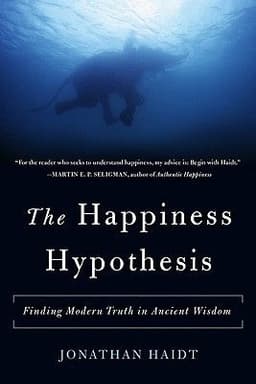
The Happiness Hypothesis Book Summary
Finding Modern Truth in Ancient Wisdom
Book by Jonathan Haidt
Summary
The Happiness Hypothesis is a thought-provoking exploration of ancient wisdom and modern science that reveals the true sources of human flourishing - love, work, virtue, and the harmony between our divided selves and our social world.
Sign in to rate
Average Rating: 5
The Mind Is Divided Into Separate Parts That Often Conflict
Haidt explains that the human mind is divided in many ways that can lead to internal conflicts. The main division discussed is between the conscious/reasoned processes and the automatic/implicit processes. He uses the metaphor of a rider (controlled processes) on an elephant (automatic processes) to illustrate that the rider often struggles to control the much larger and more powerful elephant. While the rider can try to guide the elephant, ultimately the elephant determines most of our behavior.
Section: 1, Chapter: 1
Our Minds Are Divided In Four Main Ways
The four main divisions of the mind discussed are:
- Mind vs Body - Different parts of the body, like the gut, have their own "minds" that function separately from the brain
- Left brain vs Right brain - The two brain hemispheres have specialized functions
- New brain vs Old brain - Evolutionary newer brain regions sometimes conflict with older regions
- Controlled vs Automatic processes - Conscious controlled processes are limited, while automatic processes handle most of our behavior
Section: 1, Chapter: 1
The Rider Evolved To Serve The Elephant
Haidt argues that while language and reasoning skills (the rider) evolved relatively recently, automatic processes and emotions (the elephant) have been evolving for hundreds of millions of years to quickly respond to our environment. The rider therefore did not evolve to be in total command, but rather to work together with and serve the elephant's needs. The rider provides some guidance but is mostly just an advisor to the elephant.
Section: 1, Chapter: 1
Thinking Changes How We Perceive Things
The main idea of this chapter is captured well in two quotes - one from Shakespeare that "There is nothing either good or bad, but thinking makes it so", and one from Buddha that "Our life is the creation of our mind." In other words, while we cannot always control what happens to us externally, to a large extent our experience of life depends on how we interpret and react to events mentally. This is a core tenet of Cognitive Behavioral Therapy.
Section: 1, Chapter: 2
Techniques For Retraining The Elephant To Be More Positive
Haidt describes three main methods for shifting one's automatic patterns of thinking in a more positive direction:
- Meditation - Practicing focused attention weakens attachments and provides distance from one's normal train of thought, allowing negative patterns to be recognized and disengaged from
- Cognitive therapy - Systematically catching, labelling and challenging negative thoughts and cognitive distortions to develop more balanced thinking habits
- Prozac - Medications that act directly on neurotransmitters like serotonin to alter automatic responses, especially when therapy alone is insufficient
Section: 1, Chapter: 2
Prozac Can Be A Useful Shortcut
For people who struggle with anxiety, negativity and pessimism due to their inborn temperament (neurochemistry), Haidt believes Prozac and similar antidepressants can be a legitimate shortcut to a healthier mood baseline. While the ideal may be to change one's thinking habits directly through therapy, this is very difficult for some people. Responsible use of medication combined with therapy and other healthy habits can make real change possible that would otherwise be out of reach. It provides a stepping stone to implementing other positive practices.
Section: 1, Chapter: 2
The Rule Of Reciprocity Is The Basic Currency Of Social Life
Reciprocity, or paying back what others do to you (good or bad), is a human universal found in all cultures. It allows for cooperation between individuals who are not related. The tit-for-tat strategy - being nice until provoked, but then retaliating if wronged - tends to lead to the best long-term outcomes in social interactions. Behaviors like gratitude and vengeance exist to reinforce and motivate adherence to reciprocity.
In addition to gratitude and vengeance between two interacting individuals, gossip is a mechanism that promotes reciprocity and cooperation on a larger societal scale. Language may have evolved primarily to facilitate gossip - allowing people to keep track of who is doing what to whom, so cheaters can be punished and cooperators rewarded, even by those not directly involved. Gossip extends reciprocity beyond direct dyads.
Section: 1, Chapter: 3
Salespeople Exploit The Rule Of Reciprocity To Influence Customers
Haidt gives the example of Hare Krishna followers who would forcefully give flowers to passersby and then request donations. Most people, having accepted the small gift, would feel obligated to give something back in return. Salespeople use similar techniques like free samples or gifts to invoke an obligation in customers through the reciprocity principle. One must actively resist these influence attempts once recognized.
Section: 1, Chapter: 3
Balance Giving And Taking In Relationships
In personal relationships, especially new ones like dating, there is a delicate balance to maintain in terms of reciprocity. Giving too much too soon may come across as desperate, while giving too little seems aloof and uncaring. The relationship develops best with matched and escalating exchanges of giving, sharing and vulnerability. This back-and-forth builds trust and liking. Try to match the other person's pace and level of sharing.
Section: 1, Chapter: 3
We Suffer From A "Myth Of Pure Evil" When Judging Others
Haidt argues that people have a tendency to view those they disagree with as purely evil, rather than recognizing the complex motivations and situational factors that drive most human behavior. We readily see the faults in others but struggle to recognize our own biases and hypocrisies. This myth of pure evil leads to unnecessary hostility and conflict between individuals and groups. In reality, very few people are deliberately malicious - most believe that their actions are justified.
Section: 1, Chapter: 4
Our Biased Perceptions Make It Very Difficult To See Our Own Faults
Several cognitive biases contribute to people's inability to see their own faults while readily seeing them in others:
- The Bias Blind Spot - We see others' judgments as biased but not our own
- Naive Realism - We believe we see objective reality and that reasonable people will agree with us
- Cognitive Dissonance - We deny or rationalize facts that conflict with our self-image as a good person
- Confirmation Bias - We seek information that supports our existing beliefs and ignore contrary evidence
Because of these powerful self-serving biases, it is very difficult to recognize our own moral failings and hypocrisies.
Section: 1, Chapter: 4
Finding Your Own Faults Is The Key To Escaping Hypocrisy
Most people readily see the faults and biases of others, but have a very difficult time recognizing those same faults in themselves due to self-serving biases. The only reliable way to avoid self-righteousness and hypocrisy is to actively search for your own faults and contributions to conflicts.
When you find even minor ways that you acted poorly or hypocritically, it becomes much easier to forgive the faults of others and reconcile differences. Seeing your own role in conflicts also short-circuits anger and makes empathy possible. Make a habit of searching for your own faults, however small, rather than focusing on the obvious faults of others.
Section: 1, Chapter: 4
Myths And Misconceptions About What Makes People Lastingly Happy
Haidt debunks several popular myths about happiness, such as:
- Achieving major life goals like wealth, beauty, or prestige will make you lastingly happier
- Getting what you want always makes you happier
- Happiness comes either only from within (internal) or only from without (external)
- Following your gut desires and feelings will make you happy
In fact, research shows that most external conditions have a surprisingly minor impact on long-term happiness levels. Many apparent goods are subject to hedonic adaptation, fading quickly. The clearest external predictors of happiness are strong relationships, meaningful work, and connection to something greater than oneself.
Section: 1, Chapter: 5
The Happiness Formula: H = S + C + V
Haidt presents the happiness formula, adapted from the work of Lyubomirsky, Sheldon and Schkade, as follows:
- H (Enduring level of happiness) =
- S (Set range, genetically determined, ~50%)
- C (Circumstances, e.g. income, attractiveness, disability, ~10%)
- V (Voluntary activities and effort, ~40%)
This formula summarizes the proportions of happiness attributable to genes, circumstances, and effort. It shows that while circumstances matter, intentional effort (V) can significantly raise one's happiness within their set range (S). Haidt elaborates on several effective voluntary activities, such as meditation, cognitive therapy, and Prozac.
Section: 1, Chapter: 5
Finding Flow In Work And Relationships Is Key To Lasting Fulfillment
Haidt, drawing on the work of Mihaly Csikszentmihalyi, discusses the importance of flow states - times of full engagement and absorption in challenging activities that draw on one's strengths.
Finding flow in one's work is a major contributor to happiness and meaning in life. Flow produces lasting satisfaction in a way that momentary pleasures do not. The other key factor is close relationships - having people to share joys and sorrows with provides an enduring boost to wellbeing. In summary, the conditions for happiness are finding flow (especially in work) and love (especially through relationships).
Section: 1, Chapter: 5
Focus On Improving Relationships And Pursuing Flow
To increase your enduring happiness, invest effort (the V in the happiness formula) in two key areas:
- Relationships - Put time and energy into forming and maintaining close social bonds. Express affection and gratitude. Seek reconciliation if ruptures occur. Close, stable relationships are the single biggest predictor of happiness across the lifespan.
- Flow - Structure your days around pursuing challenging activities that engage your skills and passions. Minimize passive pleasures in favor of active engagement, especially at work. Organize your environment to make flow (and relationships) easier.
Resist the cultural messages that happiness comes from achieving major goals like wealth, beauty or status - the fleeting boosts they provide are not worth sacrificing relationships and flow.
Section: 1, Chapter: 6
We Never Outgrow Our Need For Attachment And Connection
Attachment theory, developed by John Bowlby and Mary Ainsworth, shows that humans have an innate need to form close bonds with caregivers from infancy onwards. The quality of early attachments shapes people's ability to connect with others throughout their lives.
While attachments to parents are primary in childhood, attachments to friends and romantic partners become central in adolescence and adulthood. The need for secure attachments never disappears - even adults need a "secure base" to retreat to in times of distress. Ruptures in attachments lead to anxiety and difficulty in functioning at any age.
Section: 1, Chapter: 6
Passionate And Companionate Love Work On Different Time Scales
Haidt distinguishes between two main types of love:
- Passionate love - The intense, "in love" feeling characterized by strong emotions, obsessive thoughts, and a desire for union. Passionate love sparks quickly but fades within months or years due to hedonic adaptation.
- Companionate love - The deep affection and care that develops slowly over time as partners' lives intertwine. Companionate love grows through many small interactions of support and understanding.
Marriages based on passionate love alone often fail as the intensity fades. Enduring love combines passion with a solid foundation of companionship. Many arrange marriages work surprisingly well because they skip the passionate phase and build companionate love from the beginning.
Section: 1, Chapter: 6
Prioritize Your Closest Relationships Over Personal Achievement
Relationships, not individual achievement, are the key to lasting happiness and health. Neglecting close bonds in pursuit of self-oriented goals is destructive. Make a habit of considering your partner's, family's and friends' needs alongside your own.
Compromise where necessary to maintain relationship harmony, rather than insisting on maximizing your personal preferences. Express affection, gratitude and admiration liberally - these positives should outweigh negatives by at least 5:1 in good relationships. Make time for shared activities and rituals that bring you together. Strong, stable relationships are a necessary condition for long-term well-being.
Section: 1, Chapter: 6
The Uses of Adversity
Haidt explores the concept of post-traumatic growth - the idea that struggling with adversity can sometimes make people stronger, wiser, and more fulfilled in the long run. While trauma is of course negative in the short-term, overcoming it can increase resilience, self-understanding, and ability to cope with future challenges. Key mechanisms of growth include:
- Revealing hidden abilities and changing self-concept
- Strengthening relationships through crisis
- Shifting priorities and philosophies
Not all adversity leads to growth - trauma can be shattering if it is too severe or the person lacks sufficient support and resources to cope.
Section: 1, Chapter: 7
The Three Levels Of Personality
Haidt presents McAdams' three levels of personality:
- Dispositional traits - Stable, heritable characteristics (e.g. Big 5 traits)
- Characteristic adaptations - Acquired goals, defenses, and values that help one succeed in a chosen niche
- Life stories - Evolving narrative identity one constructs to make sense of their life
Fulfillment and growth are most likely when the three levels are in harmony - for example, when one's life story and goals fit well with their deepest traits and values. Adversity sometimes forces a realignment of the levels, breaking one out of a stagnant or conflicted pattern.
Section: 1, Chapter: 7
The Felicity of Virtue
Haidt contrasts ancient philosophies of happiness with modern ones. He argues that thinkers like Aristotle, the Stoics, Buddha, and Confucius rightly saw virtue and character development, not just subjective pleasure, as the keys to a fulfilling life.
The ancients recommended practicing virtues like courage, moderation, justice and wisdom until they became ingrained habits. In contrast, modern philosophies tend to emphasize either raw subjective experience (hedonism) or abstract rules (deontology, utilitarianism). As a result, modern life is often unmoored from considerations of virtue and character, and people struggle to find moral clarity and meaning.
Section: 1, Chapter: 8
"Happiness Comes From Between"
"What can you do to have a good, happy, fulfilling, and meaningful life? What is the answer to the question of purpose within life? I believe the answer can be found only by understanding the kind of creature that we are, divided in the many ways we are divided. We were shaped by individual selection to be selfish creatures who struggle for resources, pleasure, and prestige, and we were shaped by group selection to be hive creatures who long to lose ourselves in something larger. We are social creatures who need love and attachments, and we are industrious creatures with needs for effectance, able to enter a state of vital engagement with our work. We are the rider and we are the elephant, and our mental health depends on the two working together, each drawing on the others' strengths."
Section: 1, Chapter: 8
Positive Psychology Is Reviving The Ancient Emphasis On Virtue
Haidt discusses how the positive psychology movement, pioneered by Martin Seligman, is reviving some ancient wisdom about happiness and virtue.
Positive psychology focuses on identifying and cultivating individual and societal strengths and virtues, not just treating disorder and dysfunction.
Seligman and Peterson developed a framework of 6 core virtues and 24 specific character strengths, drawing on both ancient philosophies and modern psychological research. The framework provides a way for people to identify their signature strengths and organize their lives around them. Exercising one's strengths is inherently rewarding and contributes to a sense of meaning and engagement.
Section: 1, Chapter: 8
Organize Your Life Around Your Strengths And Virtues
Take the VIA Signature Strengths assessment to identify your core character strengths and virtues (available free online). Pick one top strength to focus on cultivating each month. Look for new ways to apply the strength in your daily life and reflect on how it contributes to your sense of fulfillment and connection.
Think about how the strength can be used to benefit others, not just yourself. When facing challenges, consider how your strengths can help you cope and maintain your integrity. Choose work and relationships that allow your strengths to be expressed. Make exercising your strengths a daily priority and notice how this affects your overall happiness and sense of meaning over time.
Section: 1, Chapter: 8
People Have A Natural Sense Of The Sacred
Haidt argues that the human mind is predisposed to perceive sacredness and divinity, regardless of religious belief. He discusses how notions of sanctity, purity, elevation and degradation shape moral thinking across cultures.
Things seen as holy or sacred are treated as inviolable and protected from the corrupting influence of the profane or carnal. This "ethics of divinity" was central to most ancient cultures but has waned in the secular modern West. Yet even modern people experience quasi-religious elevation in response to extraordinary virtue and beauty. Haidt argues that the emotion of moral disgust evolved to help enforce the sacred/profane boundary.
Section: 1, Chapter: 9
Giving Teens Peak Experiences And Rites Of Passage
In our secular modern society, teenagers often lack structured rites of passage and access to self-transcendent experiences. Parents and educators could help meet this need by:
- Exposing teens to awe-inspiring art, music and nature
- Encouraging service activities that induce a sense of elevation and connection
- Providing physically and mentally challenging rites of passage (e.g. wilderness trips)
- Allowing semi-structured spiritual explorations and discussions
The goal is to give teens opportunities to experience self-transcendence and develop their own sense of meaning and sacred purpose. Experiencing ego-loss and deep connection can provide an enduring sense of perspective throughout life.
Section: 1, Chapter: 9
Religion Binds Individuals Into Cohesive, Cooperative Groups
Haidt examines religion through the lens of evolutionary psychology and cultural anthropology. He argues that religious practices emerged in part to solve the problem of group cohesion and cooperation.
Participation in sacred rituals, adoption of shared beliefs/norms, and subjugation to moral authorities allowed people to identificatify as part of a united whole, putting group interests above selfish interests. The experience of self-transcendence and ego-loss induced by certain practices also promotes a sense of connection and commitment.
While modern secular societies have found alternative sources of order and meaning, they continue to struggle with individualism, alienation and loss of community. Understanding religion's cultural evolutionary role is essential for addressing modern social challenges.
Section: 1, Chapter: 10
Pursue Coherence And Connection For A Meaningful, Fulfilling Life
Haidt's closing advice is to pursue cross-level coherence and connection. Specifically:
- Cultivate close, committed relationships and prioritize them even when inconvenient. Express appreciation often.
- Seek work that engages your strengths and passions and links you to something larger than yourself. Focus on mastery, not just success.
- Find ways to lose yourself regularly in experiences of awe, beauty and self-transcendence, whether through nature, art, spirituality, or service.
- Reflect on how your life fits into the larger cultural story and pursue goals that are meaningful in that context.
- Live ethically and cultivate virtues, not just for yourself but for the benefit of your community.
A good life is found in the balance, in the "between" - pursue it there and a sense of meaning and fulfillment will emerge organically over time.
Section: 1, Chapter: 11
Related Content
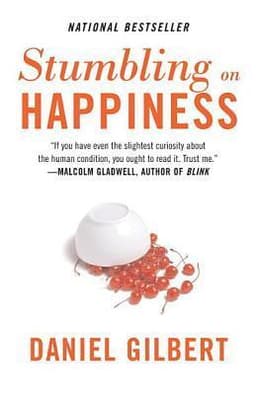
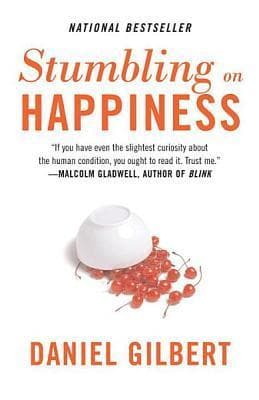
Stumbling on Happiness Book Summary
Daniel Gilbert
Harvard psychologist Daniel Gilbert takes readers on a whirlwind tour of the human brain, exploring how our unique ability to imagine the future often leads us astray in predicting what will make us happy. Gilbert argues that the futures we envision are often distorted by our current emotions, our flawed memories, and our psychological blind spots - but recognizing these limitations, we can learn to more accurately forecast our feelings and maximize our well-being.
Harvard psychologist Daniel Gilbert takes readers on a whirlwind tour of the human brain, exploring how our unique ability to imagine the future often leads us astray in predicting what will make us happy. Gilbert argues that the futures we envision are often distorted by our current emotions, our flawed memories, and our psychological blind spots - but recognizing these limitations, we can learn to more accurately forecast our feelings and maximize our well-being.
Happiness
Psychology
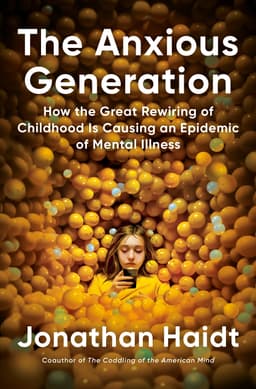
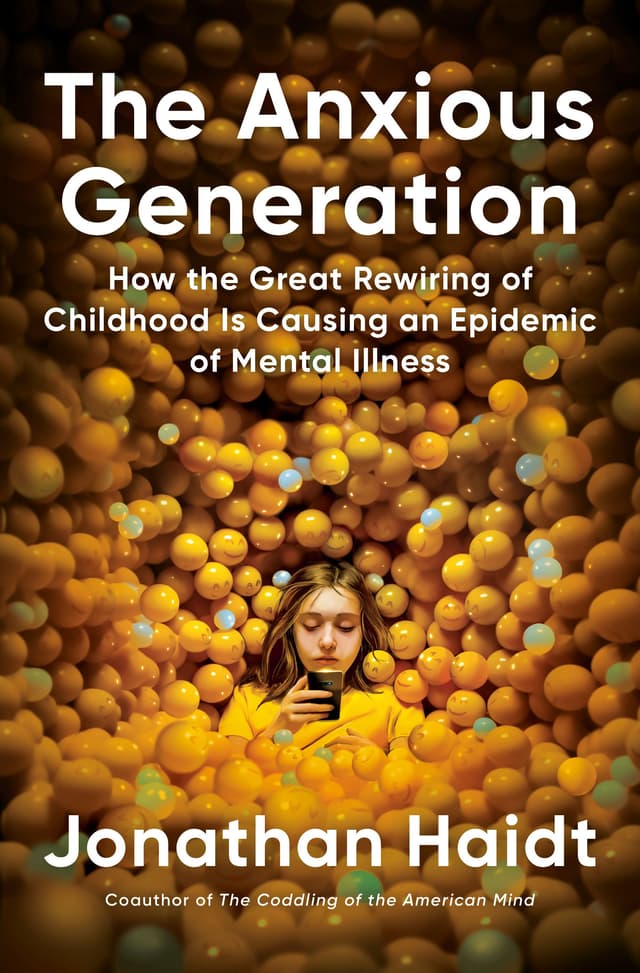
The Anxious Generation Book Summary
Jonathan Haidt
In The Anxious Generation, Jonathan Haidt traces the sudden rise of teen anxiety, depression, and self-harm to the simultaneous decline of free play and rise of smartphones. Haidt shows how restoring the pillars of a play-based childhood may be the key to reversing the mental health crisis engulfing Gen Z.
In The Anxious Generation, Jonathan Haidt traces the sudden rise of teen anxiety, depression, and self-harm to the simultaneous decline of free play and rise of smartphones. Haidt shows how restoring the pillars of a play-based childhood may be the key to reversing the mental health crisis engulfing Gen Z.
Psychology
Mental Health

